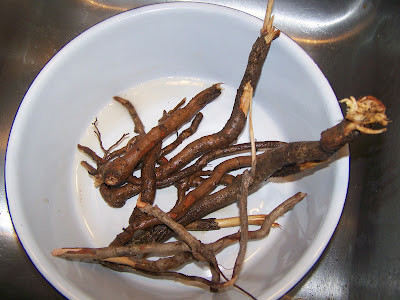50°f this a.m., or 10°C. Cloudy after a night of rain showers.
Have you had your cup of sassafras tea yet?
It’s the time of year for spring tonics, and sassafras is one of the most popular cures for winter drabness. Old-timers around here will tell you that sassafras “thins the blood,” which was believed to help handle hot weather with less discomfort. Many people no longer drink sassafras tea because several creditable government reports warned that sassafras is carcinogenic. I am one of those living dangerously, imbibing sassafras tea eagerly as soon as the ground is thawed enough to dig the roots. Anyway, apparently I would need to drink about 10 gallons a day for months to have even a slight danger from sassafras, so I figure I’m safe.
Sassafras roots
If you heed the government warnings and shy away from sassafras, fear not. Spring greens are the ultimate tonic for the winter weary. And if your lawn is like mine, you have a salad garden right at hand. Violet leaves, daylily shoots, young plantain leaves, wild lettuce, sourweed, and many other old favorites are ready for the picking in the yard or along fencerows. Guidebooks can help identify the early greens, but an even better guide is an elderly neighbor who can pass on cooking tips and stories of the old days when everyone sought the wild “creasy greens,” one of the earliest and most delicious of the early greens. Also known as wild mustard and wild cress, this plant is abundant in abandoned fields in our area, often creating a sea of yellow when it goes to bloom.
The variety of names given to some wild plants, like creasy greens, is astounding. I remember once telling a neighbor about my favorite wild green, lambsquarters. She said, “I’ve never heard tell of that.”
“Why, it grows all over the place,” I said. “I can’t believe you’ve never seen it or eaten it.”
“Can’t say as I have,” she said. “What’s it look like?”
I began describing the plant that liked to grow in rich soil and was covered with silvery leaves that had a grainy feel. She shook her head. “Nope. Never seen anything like that.”
Later we walked out to her garden. There, growing along the garden fence was a lush patch of lambsquarters. “There!” I said. “You’ve got loads of lambsquarters!”
“Oh, that? Why that’s silvey. That’s a real good green for cooking. I didn’t never hear of it being called what you called it, though.” The difference between learning the plants from books, and learning them from someone who has a long and familiar acquaintance with the natural world around them.
My favorite spring tonic is one that I don’t drink or eat. It’s a song, lovely and lonely, sung in the deep of springtime woods when the air is soft and the night is young. It’s the whippoorwill, calling out a song of love and hope. That is, without a doubt, the very best medicine of all, for when the whippoorwill sings, the cold of winter is usually behind us., although this year the poor bird had to endure 30-degree nights on its return on April 17th.
Yesterday, after 3+hours finishing up tilling the garden, I was more than ready to sit on the porch with a glass of my favorite spring tonic. Cheers!



Sassafras leaves have a similarity to fig leaves.
ReplyDeleteI could certainly do with a spring tonic..and I am busy eating my greens and salad leaves!
Good deal! Nothing like the early greens. I had never thought about the similarity of the leaves, but you're right.
DeleteHave never heard of or seen sassafras tea...would love to try some!
ReplyDeleteVery like root beer, Angie.
DeleteI've had sassafras tea before it was considered carcinogenic. The food co-op would sell little jars of broken roots. It reminded me of "rootbeer." I sweetened it a bit of course. But haven't had it for over 40 years now.
ReplyDeleteI remember even the grocery stores selling sassafras extract! No more though. Sad, that.
DeleteMy father always had a sassafras (ha! Autocorrect keeps trying to change that to massacre!) root on hand, but he also swore by pennyroyal.
ReplyDeleteInteresting! We have pennyroyal on the farm. Funny about autocorrect!
DeleteThe interwebs say root beer once had root bark of the sassafras but it was discontinued after the liver warning came out. I used to love root beer, actually I still do but I never buy it anymore. Not from any fear of carcinogens. Maybe because of the sugar. At any rate, enjoy your tea.
ReplyDeleteI did not know that about root beer. Funny how we quit eating or drinking some things as we get older. And add others.
DeleteThe government seems to think a lot of natural things are bad for you...sigh. I haven't had sassafras, but would give it a go. So many great things in nature that are good for us.
ReplyDeleteI know. I try to be sensible about it.
DeleteLOL, reckon you are safe! Does it grow here? I´ve really never heard of it!
ReplyDeleteLearning is... fun and spring tonic sounds fun!
Here still way too cold with 5C/41F...
You keep a tradition alive.
ReplyDeleteIt’s a long time since I hear a Whippoorwill. Like so many other birds (most in fact) they are in steep decline.
ReplyDelete